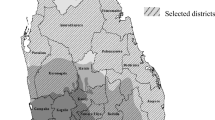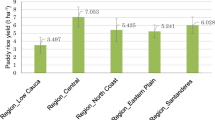Abstract
This chapter measured the interacting effects of paddy yield determinants using path analysis. The data was sampled in 2014, from 301 paddy fields planted with Koshihikari, from two large-scale farms in Japan. The result indicated that there are significant interactions among the determinants, which affect the total yield in the form of indirect effects. Solar radiation and temperature had the most effect; and the former affected the latter significantly.
Access provided by Autonomous University of Puebla. Download chapter PDF
Similar content being viewed by others
This chapter measured the interacting effects of paddy yield determinants using path analysis. The data was sampled in 2014, from 301 paddy fields planted with Koshihikari, from two large-scale farms in Japan. The result indicated that there are significant interactions among the determinants, which affect the total yield in the form of indirect effects. Solar radiation and temperature had the most effect; and the former affected the latter significantly. Farm difference was another important factor in explaining yield variation among paddy fields, through indirect effects. In addition, we examined the interaction with paddy yield and the determinants, using a two-year sample of 117 paddy fields planted Koshihikari, from a farm in the Kanto Region. This chapter expanded the sample by including the ratio of full-grain rice in sorted brown rice to identify the interacting determinants of paddy yield, grain quality, and their determinants.
1 Introduction
Paddy production in Japan is transiting from acreage reduction to improvement in efficiency and competitiveness, by decreasing production costs. In 2014, the yield of sorted brown rice was 8.43 million metric tons, a decreased of 40% from 11.83 million metric tons in 1985 (MAFF 2016). In 2013, the average production cost of sorted rice in Japan was 258 JPY per kilogram (E-Stat 2015), much higher than that of the US, at 35 JPY per kilogram on average (USDA 2014). Higher yield and quality are essential for improving rice productivity and market competitiveness. Koshihikari is the most widely planted rice variety in Japan and is exceedingly popular for its aesthetic appearance and palatability. It accounts for around 37% of the total area under rice cultivation (Komenet 2020). We measured the interacting effects of paddy yield determinants, based on the data from 301 paddy fields of two farms growing Koshihikari.
2 Materials and Methods
2.1 Data of the Two Farms
The data was collected in 2014 from two farms—23 hectares and 36 hectares in size—located in the Hokuriku and Kanto Regions, respectively. With relatively limited farmlands of 40 hectares in total, farm B adopted an intensive input strategy (e.g., more nitrogen fertilizer). In contrast, the paddy fields in farm Y were extensive in space distribution, with much larger farmlands of 125 hectares and higher soil capacity.
The yield was measured by paddy with 15% moisture. As shown in Table 1, the determinants included: (1) dummy variable of farm (0 = farm Y, 1 = farm B); the continuous variables of (2) field area, (3) nitrogen fertilizer amount; (4) solar radiation and (5) temperature 20 days since full-heading; (6) panicles per hill and (7) plant height in heading stage; and (8) land capability measured using the principal component of 21 soil property indices (Table 2). As a structural equation modeling (SEM) technique, path analysis was performed using IBM Amos 23.0, to measure the direct effects among the determinants.
Rice yield was weighed by paddy with 15% moisture content, and the ratio of full-grain rice was measured using grain analyzer RGQ120A, a product of Satake Co., Ltd. The entire farm was scaled at 125 hectares, while the sampled 117 fields were 34 hectares in total acreage. The average yield per hectare in 2014 and 2015 were 6705 kilograms and 6155 kilograms, respectively. Simultaneously, the ratio of full-grain rice reduced from 67 to 62%, with a larger coefficient of variance of 19.78% in 2015, compared to 8.40% in 2014. Path analysis was performed to measure the direct, indirect, and total effects.
2.2 Data of One Farm in Two Years
Similarly, summary statistics of rice yield, quality, and determinants in 117 fields were shown in Table 3. The two-year data were provided for comparison, in terms of the minimum, maximum and average values, standardized deviation, coefficient of variance (CV), and differences of the annual means.
3 Results
3.1 Results of the Two Farms
In the path diagram (Fig. 1), logarithms of continuous variables were used to include more linear relationships. The numbers over the single arrowhead lines are the standardized path coefficients. They designate the direct effects of the original variables on the targeted variables and allow a direct comparison among variables. For instance, the standardized path coefficient from the culm height was 0.17. It is higher than the panicles per hill, 0.12, and thus the former affects paddy yield more than the latter, ceteris paribus. Each circled e-i (i values 1–8) represents a residual—unmeasured causes of the endogenous variable. The model fit indices RMSEA = 0.049 and CFI = 0.997 showed that the model had a high goodness of fit (Kline 2011).
Table 4 summarizes the interacting effects of the variables. The direct effects are the path coefficients in Fig. 1; the indirect effects include all the other concerned path coefficients; while the total effects aggregate both. For instance, the total effect of plant height (0.19) was the sum of the direct effect (0.12) and the indirect effect via panicles per hill (0.43 × 0.17). The paddy yield was determined mainly by solar radiation, temperature, farm, land capacity, sorted considering the magnitude of the total effect.
Farm had the largest direct effect, followed by temperature, solar radiation, and so forth. Meanwhile, solar radiation had the largest indirect effect, through higher temperature and plant height, and hence more panicles per hill. Meanwhile, paddy yield was influenced by field area via nitrogen amount and land capability—by nitrogen amount via panicles per hill; by land capability via plant height and panicles per hill; and then by plant height via panicles per hill. In terms of the total effects, paddy yield was determined by solar radiation and temperature first, followed by farm, land capability, field area, plant height, panicles per hill, and nitrogen amount (Fig. 2).
3.2 Result of One Farm in Two Years
Figure 3 shows the variables and path diagram, where logarithms of continuous variables with a hectare base were used to include more linear relationships. The numbers over single arrowhead lines are the standardized path coefficients, designating direct effects of the origin to the target. Each circled e-i (i values 1–10) represents a residual; the numbers over two arrowhead lines are correlation coefficients. The fit statistics (i.e., RMSEA < 0.1) showed that this model fitted the data well (Kline 2011).
Table 5 summarizes the total effect aggregating the direct effect (i.e., the path coefficients shown in Fig. 3) and the indirect effects (i.e., all the other path coefficients via other variables). For instance, the total effect of culm length (0.30) to paddy yield was the sum of the direct effect (0.23) and indirect effect via panicles per hill (0.41 × 0.19).
4 Discussion
4.1 Effect of Farm Difference
Like the comparison shown in Table 1, all the determinants were significantly different between farms and in terms of the path coefficients (Fig. 1). The variation in the difference and direct effect for all the determinants were shown in Fig. 4, except for temperature. This revealed that temperature is strongly affected by solar radiation, indicated by the path coefficient of 1.23 from solar radiation to temperature. Thus, temperature tends to be higher in farm B, excluding the effect via solar radiation.
4.2 Solar Radiation and Temperature
As shown in Fig. 5a, significant linear relationship was found between the two variables in the sampled 301 fields. The high determination coefficient, R2 = 0.934, was significant at the 0.01 level, demonstrating the high path coefficient from solar radiation to temperature. Farm Y was higher than farm B on both indices.
4.3 Panicles Per Hill and Plant Height
There was a significant linear relationship between the two variables (Fig. 5b). Both were significantly and positively correlated with paddy yield (Fig. 6a, b). Plant height in farm B was greater than in farm Y. In addition, according to the total effects in Table 4, these two growth indices were affected by land capability, solar radiation, and field area.
As the most significant growth indices, both culm length and panicle number per hill were positively related to rice yield. In addition, there was a significant positive relationship between them (Fig. 7).

(Source Li et al. 2016)
Field area farming condition and rice yield in 117 fields of farm Y. a Culm length (cm). b Panicles per hill. c Culm length (cm)
4.4 The Other Determinants
The amount of nitrogen fertilizer was positively related with yield via panicle number. Meanwhile, there was a quadratic relationship with yield, showing that yield peaks at roughly 95 kilograms per hectare (Fig. 6c). Field area was positively related with yield via nitrogen fertilizer, land capability, panicle number, and plant height. The quadratic relationships indicated that, land capability peaks when paddy fields are scaled at roughly 0.76 hectares (Fig. 6d).
5 Conclusion
With high goodness of fit, the path analysis models identified the interactions between the significant determinants of paddy yield. Paddy yield was determined mainly by field conditions including, solar radiation, temperature, and land capacity. In accordance with the corresponding managerial strategies, farm B had a higher yield than farm Y on average, judging from the effect of the dummy variable.
The mutual causality of paddy yield and grain quality was illustrated through a bidirectional path. This revealed that an increase in yield relates to higher grain quality, while emphasizing on higher grain quality tends to result in a lower yield. The time trend, year, induced significant reduction in both quality and yield after controlling the implicit changes. This was in accordance with the fact that among all the other variables, only nitrogen fertilizer per hectare increased from 52 kilograms to 76 kilograms in the two years. In contrast, field area and planting condition score were shown as affecting both yield and grain quality positively and significantly. Culm length significantly affects panicles per hill, both are important growth indices in determining paddy yield and quality. Solar radiation significantly affected temperature. Solar radiation and temperature exerted positive effects on paddy yield, and they are negatively related to grain quality. The amount of nitrogen fertilizer affected paddy yield mainly through a longer culm. Inorganic nitrogen, the sum of ammonium and nitrate nitrogen, affected both quality and yield, through a longer culm and more panicles per hill. Base saturation, sum of the saturation of potassium, lime, and magnesia, were shown to have a positive effect on paddy yield.
References
E-Stat. (2015). Statistics on the crops planted in 2014. http://www.e-stat.go.jp/SG1/estat/List.do?lid=000001129556 (in Japanese).
Kline, R. B. (2011). Principles and practice of structural equation modeling (3rd ed., pp. 204–208). New York: Guilford Press.
Komenet. (2020). Information on production of rice in Japan. https://www.komenet.jp/data/jukyuudb/jukyuudb2/ (in Japanese).
Li, D., Nanseki, T., Matsue, Y., Chomei, Y., & Shuichi, Y. (2016). Variation and determinants of rice yields among individual paddy fields: Case study of a large-scale farm in the Kanto Region of Japan. Journal of Faculty of Agriculture, Kyushu University, 61(1), 205–214.
MAFF. (2016). Statistics on agricultural production costs of Japan. http://www.maff.go.jp/j/tokei/sihyo/data/12-2.html (in Japanese).
USDA. (2014). Current costs and returns of rice. http://www.ers.usda.gov/data-products/commodity-costs-and-returns.aspx.
Author information
Authors and Affiliations
Corresponding author
Editor information
Editors and Affiliations
Rights and permissions
Copyright information
© 2021 The Author(s), under exclusive license to Springer Nature Singapore Pte Ltd.
About this chapter
Cite this chapter
Li, D., Nanseki, T., Matsue, Y., Chomei, Y., Toshihiro, B., Yokota, S. (2021). Path Analysis on the Interacting Determinants and Paddy Yield. In: Li, D., Nanseki, T. (eds) Empirical Analyses on Rice Yield Determinants of Smart Farming in Japan. Springer, Singapore. https://doi.org/10.1007/978-981-33-6256-7_5
Download citation
DOI: https://doi.org/10.1007/978-981-33-6256-7_5
Published:
Publisher Name: Springer, Singapore
Print ISBN: 978-981-33-6255-0
Online ISBN: 978-981-33-6256-7
eBook Packages: Economics and FinanceEconomics and Finance (R0)










